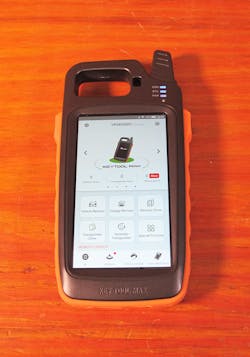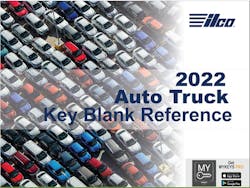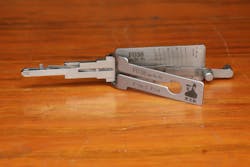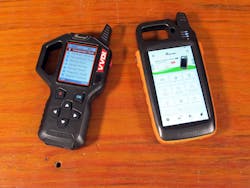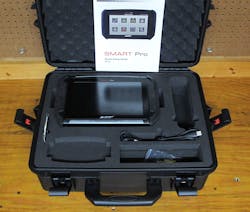When I started my career as a locksmith in 1973, the idea of specializing in automotive would have been ridiculous. Sure, making keys to cars and servicing vehicle locks were part of my job, but back then, the real money came from residential and commercial locksmithing.
As a newbie, I got stuck with one of the more tedious and repetitive jobs — installing deadbolt locks. It might be difficult to believe, but in the early 1970s, there was a huge demand for deadbolts. The brand that I installed the most was Weiser, and each Weiser deadbolt had a yellow sticker over the bolt that explained how to install it properly. I began to peel these stickers off and stick them to my toolbox. Within a year, my toolbox was covered with these stickers!
I soon began to enjoy working on cars, because it didn’t involve woodworking. I got my hands dirty, but I didn’t have sawdust and wood shavings in my hair all the time. Most of the cars that I worked on were made by General Motors, Ford or Chrysler — the Big Three. Imports were few and far between, and I mostly saw Toyota, Datsun (later Nissan) and Volkswagen.
It wasn’t until the late 1980s that automotive work made up more than 50% of our shop’s business. As a “full-service” locksmith company, we mostly did residential and commercial work, as well as safe and vault work. As the youngest person at the shop, most of the automotive work fell to me. The other two service guys were older, and one despised working on cars after he broke a window while trying to remove the clip on a door lock. (Much of the “safety glass” wound up in his toolbox, and a significant portion of it went down his shirt collar.)
Vehicles continued to evolve during the 1980s and 1990s with the introduction of higher safety standards, anti-theft systems and guards, as well as the first electronic anti-theft system, which was called VATS. Around that time, many “full-service” locksmiths began to phase out automotive work, while other locksmiths began to specialize in cars.
Today, we’re a divided industry: Most “full-service” locksmiths work on few if any vehicles, while automotive locksmiths do little residential or commercial locksmithing. The reason most often cited for this is the expense of modern automotive tools and supplies, as well as the necessity for ongoing specialized training. I keep a few Kwikset and Schlage blanks in my truck for the occasional residential lockout, but I rarely work on anything that doesn’t have wheels.
If you’ve considered becoming an automotive locksmith, this article is designed to give you an idea of the type of investment in tools and training that you’ll want to make the transformation from residential or commercial locksmith to an automotive locksmith.
For this article, I assume that you have basic locksmithing skills and tools, such as key duplicators, hand tools and a service vehicle.
When I teach a class in automotive locksmithing, I begin by telling the class that no job in the automotive field will require them to become a “rocket scientist.” The real problem is that every job is different. The techniques used to generate a key for a Ford might not necessarily apply to other domestic vehicles, imports and even other Ford products. Unlocking a Ford Mustang is a completely different type of job from unlocking a Lincoln Continental, even though Lincoln is a division of Ford Motor.
Staying up to date with what’s new in automotive locksmithing isn’t easy, and even pros often find themselves on a job that requires some new bit of knowledge or equipment. In fact, that happened to me yesterday!
I was working at a dealership on a 2020 Ford F-150 proximity key. The vehicle had two fobs, one that worked and one that didn’t. The nonworking fob had an emergency key that was cut but was obviously different from the other e-Key, which worked. The nonworking fob apparently came from a different truck. I checked the fob out with my Key Tool Max from Xhorse (Image 1), and it worked, but the tool said the chip in the fob was “locked.” Up until then, I thought Ford prox fobs didn’t “lock.” Then I checked a new fob from my stock, and the tool said it was locked as well!
A call to tech support set me straight, and it turns out the newest generation of Ford prox fobs will read as locked, but they aren’t really locked and can be programmed into a different vehicle without being “unlocked.” I then programmed the nonworking fob into the vehicle, cut a new e-Key and was done. These small-detail issues pop up on a regular basis, and I sincerely doubt whether it’s possible for any technician to know everything.
Free Information
Having the right reference materials and knowing how to find information quickly when you want it is an essential skill for any automotive locksmith. The good news is a lot of this information is free if you know where to look for it. Below is a list of some of the best free sources of information that I use on a regular basis.
Please understand that the book is essentially advertising. It does NOT list products made by companies other than Kaba Ilco. But because Ilco is the largest key-blank manufacturer in the world, that really isn’t a problem for me. Check with your distributor to see whether free copies are available. The new book normally comes out in January or February of each year, but the downloadable PDF version usually is available before the print version.
I keep versions of the past few years on my phone for easy reference. Why not just keep the most recent version? As new editions come out, Kaba Ilco sometimes make mistakes, and it sometimes removes old material that it believes is obsolete, such as platform-specific PINs for older Mitsubishi products, which I occasionally have to have.
Another free resource is the various mobile apps offered by different distributors. At the moment, I have apps offered by Locksmith Resource and Midwest Keyless on my phone. However, Locksmith Resource and Midwest Keyless, along with International Key Supply and Yellow Key Supply, have been merged into a company called Automotive Key Group that operates distribution under the name of Key Innovations. The future of the apps I use is in doubt. The Midwest Keyless app has been shut down, and the Locksmith Resource app has a disclaimer on it that lets you know you can’t order products from the app. Regardless of how this all plays out, I’m sure free locksmith apps are here to stay.
On the whole, I don’t trust YouTube as a reliable source of information, yet I use it all the time. Videos posted by individuals are often inaccurate and sometimes malicious. But if you stick to videos posted by reputable sources, there’s a lot of good information. Advanced Diagnostics, Autel, Framon Manufacturing and others maintain YouTube channels that have a wealth of good information. I often reference YouTube for programming slot locations and door-panel disassembly.
Pay to Play
My code software is indispensable, and I update it as soon as the updates become available. All of the code systems that I’m aware of now offer some indispensable tools, such as key-blank cross references, “fill” programs that help you to determine unknown cuts, key-blank information, bitting and often spacing and depth information.
Another resource that I use more often is MYKEYS Pro (Image 4) from Kaba Ilco. The base level of this product is free. The expanded Pro version requires a monthly subscription. The Pro version includes everything that’s available in the free version plus a “Complete Vehicle Programming Guide,” video tutorials and a “programmability score.” The programmability score lets you know how difficult it will be to program a specific vehicle and whether that vehicle can be programmed through the OBD port or you’ll have to pull components.
Once again, because this information is supplied by Kaba Ilco, most information will be slanted toward the Advanced Diagnostics Smart Pro and Ilco or Silca key machines and key blanks.
Michael Hyde and his company, National Auto Lock Service (www.michaelhyde.com), has produced AutoSmart books (Image 5) and software products for more than 25 years. The 2021 edition is available in print and as an app for Apple and Google Android devices, as well as the “AutoSmart Advisor,” which is for the web. The online products get minor updates continuously and a major update every other year. However, the company recently announced that the 2023 printed version wouldn’t be produced because of a paper shortage.
Tools of the Trade
Thankfully, not all automotive jobs require expensive programming devices. I still do quite a few jobs while using only hand tools and a few specialty tools.
You should know the difference between Original Lishi tools and Genuine Lishi Tools. Original Lishi tools are produced in China by Mr. Li and his company. Genuine Lishi tools are produced by several different Chinese companies, are less expensive and might or might not work as advertised. The confusion in the names comes down to the lack of copyright and patent laws in China. If you buy Genuine Lishi tools, don’t expect any after-sale support or assistance.
If you’ll work on classic vehicles, you have to have a quality steering-wheel puller and door-panel tools, but pulling the steering wheel is something that you rarely will have to do on more-modern vehicles. When I started my career in the early 1970s, an impressioning file and vise grips were the tools that I used the most. But today, with the Lishi picks and other decoders on the market, there isn’t much necessity for impressioning skills. I still do a fair amount of impressioning when I work on classic and GM Z-Keyway vehicles.
In the recent past, I impressioned keys for classic Mustangs, an MG Midget, an old Mazda pickup and a Ford F-100 pickup. However, I use impressioning the most on GM Z-Keyway vehicles. Those locks are so sloppy and wear so unevenly that you often get incorrect readings even with the best decoders. When that happens, I normally cut a key with my best guess from the decoders — but a little “high” — and then impression a finished key.
Programming Tools
In the age of transponders, programming has become a huge part of automotive locksmithing. When transponders were introduced, we had to buy the dealer programming tools, because there was no other option. Then after-market multiline programming tools began to appear. Now, so many programmers are on the market that it’s difficult to decide which one suits your requirements the best.
But please don’t make the mistake of believing that one programmer will be all that you’ll want. When starting out, you probably will have only one programmer, but as you work on more vehicles, you’ll discover that whatever tool you selected, there will be holes in the coverage.
I carry four programmers in my van — the Autel IM608, the Autel KM100, the Smart Pro and the AutoProPad from xTool. I have six more at the shop, which are a mix of old programmers and specialty programmers. I keep my old programmers, because people sometimes drive old vehicles, and some of the new programmers simply don’t include all the software necessary for older vehicles. The specialty programmers are for Audi, BMW, Volvo and VW models that I work on only occasionally. Below are several of the most popular modern programming tools on the market.
Autek IKEY 820 (Image 7). This is one of the least expensive programmers on the market, but it provides the owner with a lot. I got mine shortly after they came out and planned on using the tool as a backup. Instead, I tried using it on everything that I could, and before I knew it, it had paid for itself. I have programmed a lot of vehicles with this simple tool, including Chrysler, Ford, GM, Nissan and Toyota.
The advantage of this tool is that it usually is quick and easy. The operation is simple, and there are no tokens (software costs), and it covers a lot of different vehicles. (Note: Even though the machine doesn’t use tokens, it occasionally will pop up a message about tokens. I always ignore this message and go on without any problems. I have no idea why the message pops up occasionally, but it doesn’t affect the operation of the tool.)
The weakness of the tool is that it often doesn’t handle older vehicles well, and on many newer vehicles, it can add keys but can’t handle an all-keys-lost situation. I also found that although it programs remotes, it doesn’t do it as quickly or as easily as some of my other tools. After I bought my tool, two updates have been introduced. I added one but not the other — yet. For more information go to: http://www.autektools.com/products/ikey820/index.html.
I purchased the original Key Tool shortly after it was introduced and was amazed at how handy it was. Suddenly, I had a handheld tool that could read and write transponder keys, detect frequencies of remotes and smart keys, test transceiver rings and unlock Toyota and Lexus smart keys, as well as hundreds of other jobs that I simply couldn’t perform before. Then, along came the Key Tool Max that did all those functions and more at a reasonable price!
I recently purchased the Xhorse Key Renew adapter (full set), which works with the Key Tool Max. That should help me to unlock most of that big pile of used fobs and remotes that has accumulated in a box under the workbench. I’ve looked at other “unlocking” systems, but the simplicity, coverage and affordability sold me on this set.
I live in a resort area on the Gulf of Mexico, and “tourist season” means lots of lost or waterlogged smart keys and stranded families. In the past, I turned down a lot of smart-key business, simply because I couldn’t afford to stock the hundreds of different smart keys to handle all the possibilities.
Universal Smart Keys from Xhorse and the Key Tool Max were the first on the market and allowed me to help dozens of stranded tourists. With them, I can create a working smart key. Although Universal Smart Keys are far from universal, they’re inexpensive and cover a lot of vehicles. For more information, see your distributor or go to www.americankeysupply.com or www.uhs-hardware.com.
AutoProPad and AutoProPad G2 from xTool (Image 9). xTool has been around for years, primarily making diagnostic tools for mechanics. The AutoProPad is designed specifically for locksmiths and is backed by years of experience in other aspects of automotive computer systems. The original AutoProPad is available in three versions: Basic, Lite and Full. All three tools use the same basic machine and software. The accessories and optional components that are included with each tool are the main differences among the versions. My Full Version AutoProPad includes:
- Accessories for basic EEPROM work, such as reflashing and reading Toyota or Lexus and Honda or Acura modules
- Accessories for pre-cloning equipment for systems, such as VW/Audi/Porsche and BMW
- PIN-code-reading equipment for early Chrysler vehicles, VW and others
- Additional cables, including the old Nissan cable and others
- A “break-out” box
- A well-designed and versatile hard case
- One year of free updates and tech support
The AutoProPad doesn’t require tokens, and after the first year of updates, you can purchase additional yearly service plans.
Shortly after I renewed my annual subscription, the G2 and G2 Turbo versions were introduced. My first thought was that I just spent $600 on a tool that might just have become obsolete. But after looking into the situation, I realized that was NOT the case. The G2 versions are basically an improved tablet that runs a newer version of the Android operating system. Both versions run the same applications and have essentially the same capabilities. The G2 tablets are faster and have more memory but perform essentially the same functions. If my current tablet fails, I’ll replace it with a G2 tablet, but my existing tablet isn’t obsolete.
The G2 Turbo includes an improved system for EEPROM work that has some cool features that my old system lacks, but I do little EEPROM work, so it isn’t an issue. However, if you plan on doing EEPROM work, you should look carefully at the G2 Turbo. For more information, contact your distributor or go to https://autopropad.com/.
- Built-in Wi-Fi and Bluetooth connectivity
- Built-in operator’s manual and automotive database (AD iQ)
- Built-in accessory port for future devices and support for pre-existing devices, such as the Smart Aerial
- Easier to understand operations and menus
- Alternatives to tokens
- Elimination of dongles — particularly the much-maligned Smart Dongle
My biggest disappointment initially with the Smart Pro was the lack of improved Audi and VW software. I hoped that with the optional Smart Aerial that supported pre-coding of VAG (Volkswagen Audi Group) keys, the Smart Pro would make Audi and VW vehicles easier to service. Unfortunately, the Smart Pro had only rudimentary VAG software.
That changed a few months ago with the introduction of improved VAG software and new tools and cables that finally makes the Smart Pro a real competitor in the VAG market. In addition to the VAG software, the Smart Pro with the optional Smart Aerial now makes servicing Fiat vehicles much easier. Adding a key for a Fiat 500, by using the Ilco aftermarket fobs, the Smart Pro and the Smart Aerial, now is just as fast and easy as adding a key to a Ford! To learn more, contact your dealer or go to http://www.adusa.us/1454666/smart-pro.html.
The IM608 Pro tool from Autel (Image 11). The IM608 Pro includes software that covers most common vehicles as well as many that aren’t covered by other machines. This includes OBD support for many Audi, BMW, Mercedes-Benz and VW vehicles. The IM608 is sold in several configurations that include optional components that allow the user to handle a variety of EEPROM work as well as a “pass-through” device for vehicles that require it.
I consider the IM608 to be the most versatile of all the programmers that I own. I use it daily, and it’s a rare event when I find something that I can’t program with it. And the diagnostic capabilities of the tool allow me to perform functions that I used to send out to my local “computer guru.” (This is fortunate, because he recently decided to retire, and he now sends business to me!)
Autel recently introduced a line of universal smart keys that they call IKEYs. The IM608 as well as the KM100 (see below) can program IKEYs for a wide variety of applications, which gives me better coverage and reduces my costs. The purchase price of the IM608 includes one year of updates. After that, annual update subscriptions are offered.
The KM100 from Autel (Image 12). This tool is one that I highly recommend! In short, this inexpensive tool has the capability to program the majority of the vehicles that automotive locksmiths in North America will encounter, for a fraction of the cost of other programmers. It also can program the new Autel IKEYs. It isn’t intended to cover most European vehicles, but I programmed an IKEY into a 2013 VW Passat that used the VW push-button start system. Go to www.auteltech.com for more information.
Training Options
Obviously, if you want to use any of the above tools successfully, you have to have proper training. I still believe that hands-on training is the best. In fact, a lot of the knowledge and skills that I use every day were essentially self-taught.
I sometimes refer to the initial training that I received as “sink or swim.” After less than a month of cutting keys at the shop, another employee quit unexpectedly. I suddenly found myself with the keys to the van in one hand and a couple of service calls in the other. Those first few weeks on the road were a struggle, but I soon gained the necessary confidence, and I never looked back. Things are a lot easier today, and in addition to training at various trade shows, virtual training classes are offered by many distributors.
But no matter how much training you have, there will come a day when you find yourself working on something that you’re unprepared for. That’s the day when you learn whether you’re truly a locksmith or just a technician. I always believed that people who enjoy working puzzles make the best locksmiths. If you’re the type of person who hates puzzles, you might want to consider another career path.
Steve Young has been a locksmith since 1973 and has trained and taught locksmiths since 1988. He’s a frequent contributor to Locksmith Ledger.
